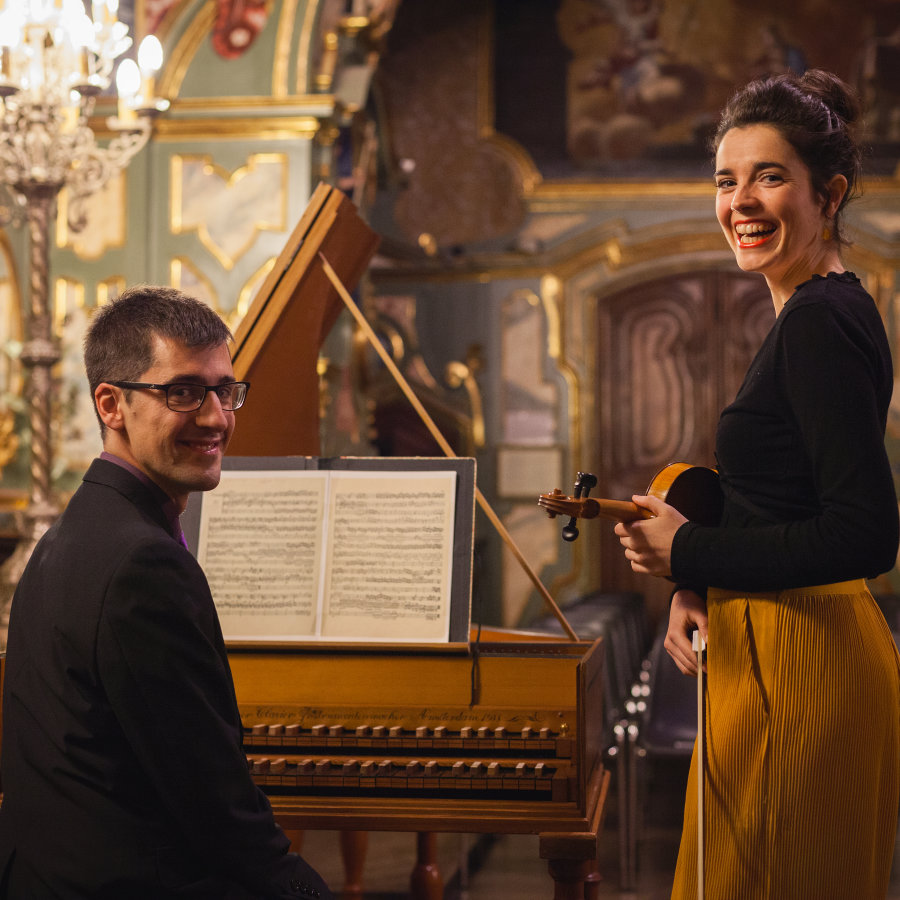
El Parnasillo

Marta Ramírez García-Mina, Violine | Eloy Orzaiz Galarza, Fortepiano
Marta Ramírez García-Mina and Eloy Orzaiz Galarza, both originally from Pamplona (Spain), established in 2015 “El Parnasillo” during their studies at the Schola Cantorum Basiliensis (Switzerland). Their shared interest in the vast repertoire for violin and keyboard has led them to look into music ranging from the early 17th century until the second half of the 19th century. Recent projects feature an exploration of the different roles each instrument can perform (as in the concert series “Solo, Continuo, Obbligato”); not so well-known Spanish composers, such as Sebastián de Albero, Francisco Corselli and other musicians of the Spanish Royal Chapel; or the evolution of the sonata genre for violin and keyboard.
“El Parnasillo” was one of the ten finalists at The York Early Music International Young Artists Competition 2019, chosen among 58 other ensembles from all over the world. Moreover, the duo has recently joined the Paris-based association “La Nouvelle Athènes” which promotes historical keyboard performance. In February 2020, “El Parnasillo” was invited to perform at the inauguration concerts of the newly restored Érard piano of 1806 (Salle Cortot and Reid Hall, Paris). In April 2021, the duo was again invited to teach a cycle of masterclasses dedicated to the French Sonata for keyboard with violin accompaniment.
Marta Ramírez García-Mina studied baroque violin at Koninklijk Conservatorium, The Hague (Walter Reiter) and Alte Musik at the Schola Cantorum Basiliensis (Amandine Beyer). She worked with numerous HIP-ensembles and orchestras. Eloy Orzaiz Galarza studied harpsichord at Prins Claus Conservatorium Groningen (Johan Hofmann) and, at the Schola Cantorum Basiliensis, harpsichord (Jesper Christensen, Prof. Jorg-Andreas Bötticher) and fortepiano (Edoardo Torbianelli, Jörg-Andreas Bötticher). He teaches harpsichord and fortepiano (CRR Saint Maur des Fossés, France, Hochschule für Musik und Darstellende Kunst Frankfurt am Main, and since 2019 at the Conservatorio Superior de Pamplona, Spain).
How did you find out about the competition “Beethoven in his time”? What did convince you to take part?
Marta's former teacher, Amandine Beyer, was the one who told us about the competition and encouraged us to take part in it.
What was the trigger that brought you to playing with historical instruments?
Well...it just makes a lot of sense to play music using the instruments it was intended for. Then the music speaks for itself, with much less effort. Playing historical instruments allows us to dive deeper into the music, to understand it better and deliver it with lots of awareness, care and respect. In fact, the fortepianos used at Beethoven's time were highly poetical. The amount of colours the player can get, added to the crystal clear basses enhances greatly its powers of expression.
And also, there is a very intuitive feature that dragged us to historical performance: the warmth in the sound, the expression, the affects, the intuitive feeling that everything made much more sense... and finally, the deep study of the sources together with the performer's authentic input creates a magic balance for us.
Was there something surprising while working on your competition repertoire?
Yes. We never heard of Wölfl before and we find his Grand Duo absolutely wonderful! Ferdinand Ries' c#minor Sonata was also full of surprises, with hundreds of unexpected modulations...
How did your preparation as ensemble work out in the Covid year?
Very good question, indeed! We could write a book full of surreal anectdotes about it. The whole process of taking part in the competition was quite a journey.
Fortunately, both of us stablished in the same city (Pamplona, Spain) right before the pandemic. That enabled us to pursue with our activities together. However, finding replicas of historical fortepianos in Spain has been a nightmare (especially a copy of a 6 octave-Viennese). We got in touch with several builders and the very few instruments were located far away from Pamplona (Madrid, Granada, Mallorca). Needless to say, we could not travel and rehearse or let alone, record using these instruments, because of the regional lockdown. Traveling to Germany was also ruled out because of the mandatory quarantine for Spanish citizens. Finally, we decided to bring both instruments to Pamplona (at a very high cost). After that, finding a place where we could place them and record was also a sort of obstacle run... eventually, the church of Berrioplano allowed us very kindly to install both instruments there. Then we had to deal with the whole acoustics matter: being quite a resonant church, capturing the right balance, clarity and reverberation with only ambient sound recording was a total challenge!
Other complications have also arisen, such as dealing with the low temperatures and extremely high humidity in the church, tuning ourselves the instruments constantly during the sessions (the change from a very dry environment in Madrid to a crazily damp church in the north of Spain was quite a shock for them!), moving them around on and off the altar in the church, finding common schedules among the church, Eloy, Marta and the person who helped us record, the expenses that this adventure has created... but step by step we have found a solution for each difficulty. The whole process has been a wonderful lesson on how to manage our energy, attention and stress.
Do you have got a favourite piece in your repertoire? And if so, which one and why?
This one is tricky. We cannot say we have a favourite piece, as all the pieces we have chosen are very dear to us, they really move us and speak to us in very different ways... We truly love the theatrical and operatic features of the Mozart sonata, the playfulness and cheeky way of writing in Beethoven's 8th sonata, the very contrasting and drammatic Beethoven's 4th, the brilliance and virtuosity of CPE Bach's Sonata, the expressivity and Romantic style of Ferdinand Ries' sonata... we have really enjoyed working on every single piece, diving deep in every composer's soundworld, bringing out the affects and effects of these true music gems.
